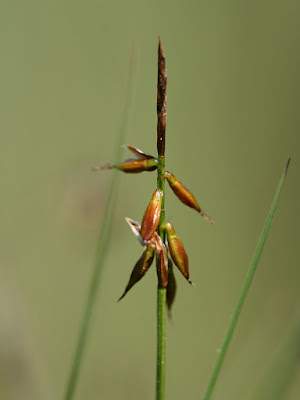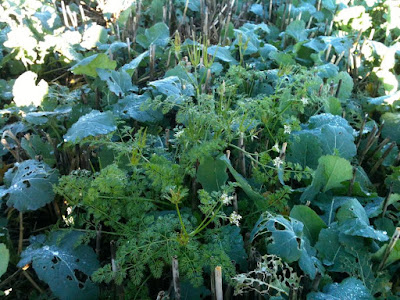As the miserable weather settles on us and we enter the season of armchair botanising (at least for higher plants), I offer my reflections on what has been a very rewarding season. These highlights are based on exciting plants I've seen this year and range from new county records and new sites for county rare plants, to re-finds of plants thought potentially extinct in the county. I can think of many further delights I'd have liked to have included, but at least that leaves plenty of material for other posts. Do let me know if there's anything you'd like to share.
A star re-find
For me the star find of the season is Rosa agrestis (small-leaved sweet briar) a nationally scarce rose and specialist of limestone grassland, mostly chalk in southern England. It has not been seen in the county for decades, but, while a rare plant, as a persistent woody species it has almost certainly been overlooked.
 |
Right: Rosa agrestis is the only sweet-briar without glands on the pedicels. The glands on the leaves can be seen clearly in this excellent image by Gareth Knass from the south of France. It is the only UK rose species with wedge-shaped (as opposed to rounded) bases to the leaflets.
New sites for county rare plants
 Carex pulicaris. Source: Wikimedia Commons |
Woodsides Meadows, a field owned by BBOWT within the Wendleybury Meads and Mansmoor Closes SSSI just to the north-west of Charlton-on-Otmoor, received a lot of attention from me this year. It's a truly flabbergasting place, and although it's been well-botanised over the years the meadow turned up a few things not previously recorded from there. The most notable were the small sedges Carex pulicaris (flea sedge) and C. hostiana (tawny sedge) - the former is known in V.C. 23 from few other sites, all old meadows, including Otmoor. These two sedges are characteristic of fens and related grassland communities which are now very rare in Oxfordshire being mostly seen in the remaining meadows of the river Ray catchment.
|
|
I also found Potentilla x mixta, the hybrid between P. reptans and P. anglica. This is a not uncommon plant in parts of the country, but there are very few records in Oxfordshire (7 records, the only recent being in 2010) - perhaps some of our P. anglica records represent misidentifications for this hybrid (17 records), or it could be mistaken for odd P. reptans.
Right: The salient features of Potentilla x mixta. Source: Whiteknights Biodiversity
|
||
One final exciting rare plant, and one I found almost on my doorstep in a rapeseed field in Islip, is Scandix pecten-veneris (shepherd's needle). This is only the fourth record of this critically endangered species in V.C. 23 this century; it is also the first record in the 10km square SP51. It was growing in some quantity along the Oxfordshire Way from Noke into Islip (SP 5368 1323) and there were a few more along the field margin.
|
 |
|
Right: The unmistakable Scandix pecten-veneris growing in an unprepossessing rapefield. These photographs of flowering/fruiting plants were taken on 19th January - maybe worth a look for my New Year Plant Hunt this January!
|  | |
Aliens
A few aliens have been added to our flora over the last year or so, mostly casual escapes from gardens. However, two of the non-native additions from this year that I'm aware of are rather more interesting.
 Dittrichia graveolens (stinking fleabane) is a short, shrubby fleabane-like member of the daisy family (Asteraceae) with which perhaps many will not be familiar (I wasn't). It is a southern European species with some determination: it has been marching northwards out of Southampton for several years and has made it as far as Greater London along the M3 (via every tetrad!). Its advance along the A34 seems to have been much more modest and it stops short at Hants/Berks border south of Newbury. However, this year I've been seeing it all over the place, including V.C. 23, where I saw some along the central reservation of the A34 near the Peartree interchange (SP4956611276). As you might have guessed it is readily identified at 70mph - in fact, I have yet to actually see the plant except through my driver-side window!
Dittrichia graveolens (stinking fleabane) is a short, shrubby fleabane-like member of the daisy family (Asteraceae) with which perhaps many will not be familiar (I wasn't). It is a southern European species with some determination: it has been marching northwards out of Southampton for several years and has made it as far as Greater London along the M3 (via every tetrad!). Its advance along the A34 seems to have been much more modest and it stops short at Hants/Berks border south of Newbury. However, this year I've been seeing it all over the place, including V.C. 23, where I saw some along the central reservation of the A34 near the Peartree interchange (SP4956611276). As you might have guessed it is readily identified at 70mph - in fact, I have yet to actually see the plant except through my driver-side window!
I received word from Matthew Berry (the BSBI aliens referee) that D. graveolens has been seen before in Oxfordshire but the records have not been submitted. I have no details, but perhaps this means its presence in the county could be much more extensive. Please keep an eye open for it on big roads! There are a few other plants found along our major roads whose frequency in the county is not, I think, reflected in the available records - a subject for a future post!
Left: Dittrichia graveolens is characteristically pyramidal in shape, and its small yellow flowers (inset) appear in September and ripen prolific fruit with a feathery pappus. Source: Wikimedia Commons
 The second non-native addition to the flora is a shield fern, Polystichum tsus-simense, a widely sold hardy Asian fern. We're used to non-native seed plants but non-native ferns are really quite unusual in the British flora. Only six records of plants established in the wild have been made, all in cities in southern England (Bath, London and Winchester), all recent (since 2008) and all in walls. The specimen I found was along the wooded bank of the Lye Valley Brook in Headington, Oxford (SP50). With milder winters perhaps P. tsus-simense might be on the increase?
The second non-native addition to the flora is a shield fern, Polystichum tsus-simense, a widely sold hardy Asian fern. We're used to non-native seed plants but non-native ferns are really quite unusual in the British flora. Only six records of plants established in the wild have been made, all in cities in southern England (Bath, London and Winchester), all recent (since 2008) and all in walls. The specimen I found was along the wooded bank of the Lye Valley Brook in Headington, Oxford (SP50). With milder winters perhaps P. tsus-simense might be on the increase?
I confess that I didn't identify this plant myself, but then it isn't in any of the books. However, I at least realised it was a bit weird and wisely showed it to Fred Rumsey, a fern referee for the BSBI, and he identified it as P. tsus-simense. It is quite different to our native Polystichum species: the frond shape is pretty much triangular, the lowest pair of pinnae being about as long as those mid-frond; its pinnules (the smaller 'leaves' of the frond) are a little like P. setiferum, making an angle of ninety degrees or more at the base, have quite long teeth (though perhaps less regular) and have a conspicuous stalk to them; however, the frond is quite glossy in texture like P. aculeatum.
Right: Polystichum tsus-simense, new to V.C. 23. Thanks to Fred Rumsey of the Natural History Museum for sending me this scan of the plant I found along the Lye Valley Brook, Oxford.


The flowers are so beautiful that they are more beautiful in nature: Dịch thuật Hà Nội, Dịch thuật TPHCM, Dịch thuật Bắc Ninh, Dịch thuật Thanh Hóa, Dịch thuật Cần Thơ, Dịch thuật Hải Phòng, Dịch thuật Đà Nẵng, Dịch thuật Nghệ An, Dịch thuật Bình Dương,.................
ReplyDelete